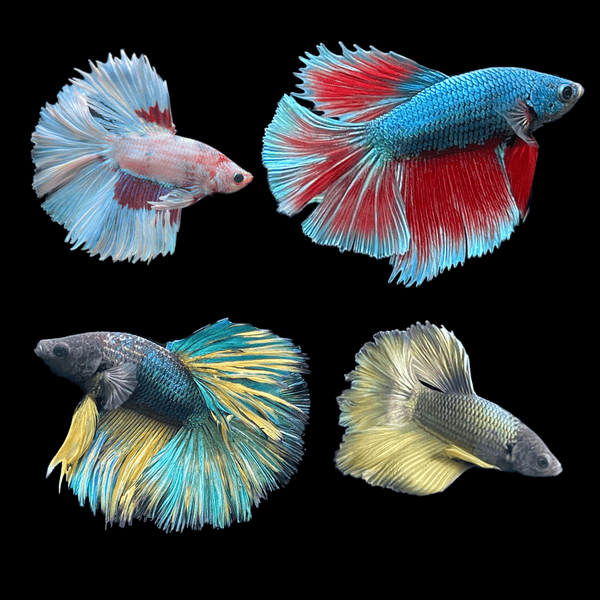Betta Fish Life-span: Just How to Guarantee Your Betta Lives Longer
Wiki Article
Just How to Breed Betta Fish Effectively: Expert Strategies and Insights for Hobbyists Seeking To Expand Their Betta Collection
Breeding Betta fish needs a nuanced understanding of genes and ecological conditions, making it vital for enthusiasts to come close to the procedure with both diligence and care. Producing an optimum breeding environment, choosing the ideal sets, and observing the intricacies of their courtship behaviors are foundational steps that can considerably impact the outcome.Comprehending Betta Fish Genes
Understanding the genetics of Betta fish is vital for effective reproduction, as it influences traits such as color, fin shape, and behavior. Betta fish exhibit a diverse range of colors and patterns, mostly determined by their hereditary makeup. The main genes responsible for coloration consist of the "B" genetics for blue, "D" genetics for red, and the "C" genetics for shade intensity. Breeders can manipulate these traits by selecting certain moms and dad fish that show wanted features.In addition to pigmentation, fin morphology is one more considerable aspect of Betta genes (betta fish). The sizes and shape of fins are influenced by numerous genetics, consisting of those that establish whether the fins are brief, long, or veil-shaped. Comprehending these genetic variants helps breeders predict the phenotypic end results of their children
Furthermore, behavioral attributes such as aggressiveness and territoriality can additionally be affected by genes. These behaviors play an essential function in the breeding procedure, as they can affect generating success and the overall personality of the resulting fry. By thoroughly recognizing these hereditary concepts, breeders can make educated decisions, inevitably enhancing their reproduction programs and achieving desirable outcomes.
Preparing the Reproduction Environment
Developing an optimum breeding setting is important for the effective reproduction of Betta fish. The initial step in preparing this environment is to choose an appropriate reproduction container, ideally ranging from 5 to 10 gallons. This dimension allows for adequate swimming area and the facility of territories. The container should be furnished with a heating system to preserve a secure temperature between 78 ° F and 80 ° F, which is important for motivating generating behavior.Next, think about the usage of a sponge filter or an air rock to provide gentle water flow without developing solid currents that can emphasize the fish. It is necessary to install plants or breeding cones to provide concealing areas and advertise convenience for the lady throughout the spawning procedure. Drifting plants, such as Java moss or water sprite, can also create a more native environment while facilitating bubble nest building by the male.
Before presenting the reproducing sets, ensure the water is conditioned and free from damaging chemicals, such as chlorine or heavy metals. betta fish. Regular water changes ought to be carried out to maintain optimal water quality, enhancing the chances of effective reproduction. With these prep work in area, the breeding setting will certainly sustain the health and wellness and health of both Betta fish
Picking Reproduction Pairs
Picking the ideal breeding pairs is critical for accomplishing successful Betta fish recreation. Healthy Betta fish show lively colors, clear eyes, and active actions.Temperament is one more vital factor to consider, as Betta fish are known for their hostile nature. It is recommended to pick a male and female that show suitable characters to lessen stress and anxiety throughout the breeding procedure. A calm man can encourage a smoother courtship, while a female that is as well hostile may interfere with the procedure.
Genetic history additionally plays a considerable duty in the high quality of the spawn. Breeding fish that are genetically diverse can minimize the threat of hereditary wellness issues and boost the overall vitality of the fry. It is advantageous to research the family tree of both the male and woman, concentrating on preferable characteristics such as fin kind, color scheme, and size.
The Breeding Refine
The reproduction process of Betta fish needs mindful planning and attention to detail to make certain a successful outcome. Initially, it is vital to prepare a suitable reproduction container, preferably a 5-10 gallon aquarium with a temperature maintained at 78-80 ° F. The storage tank must be geared up with Check Out Your URL a heating unit, filter (preferably sponge kind to stay clear of solid currents), and a lot of marine plants for the lady to conceal.Once the environment is set, introduce the chosen breeding pair to the container, permitting them to adjust. Observe click now their behavior; the male will display fancy courtship routines, including flaring his fins and developing a bubble nest. If the female shows interest, she will show vertical red stripes suggesting readiness for spawning.
When the woman is receptive, the pair will engage in a breeding accept, during which the male feeds the eggs. Preserving optimal water problems throughout this period is important for the growth of healthy and balanced Betta fry.
Caring for Betta Fry

Feeding Betta fry is important, as they need a diet regimen high in protein. Initially, they can be fed infusoria or liquid fry food, transitioning to carefully smashed high-quality pellets as they grow. Feed little sections numerous times a day to encourage healthy growth without overwhelming the container with uneaten food.

As they develop, monitor their development closely and divide any aggressive individuals to avoid damage. By providing a supporting environment and appropriate nourishment, hobbyists can efficiently increase Betta fry into dynamic, healthy and balanced fish, ultimately boosting their breeding ventures.
Conclusion
Effective Betta fish breeding needs meticulous interest to hereditary choice, environmental problems, and treatment for the fry. By comprehending the genes of Betta fish and preparing an appropriate breeding setting, hobbyists Get More Info can improve the opportunities of generating dynamic, healthy and balanced spawn. Choosing suitable reproduction pairs and carefully checking the courtship and spawning processes are crucial. Supplying optimal care for the fry guarantees their healthy and balanced growth, contributing to a thriving Betta collection.Report this wiki page